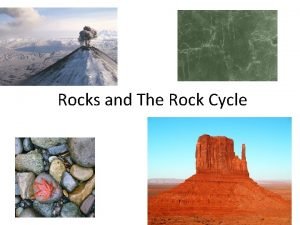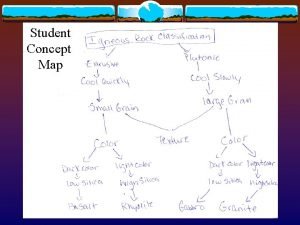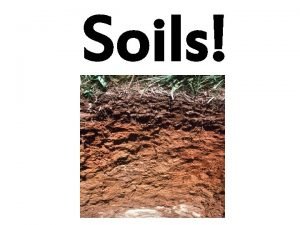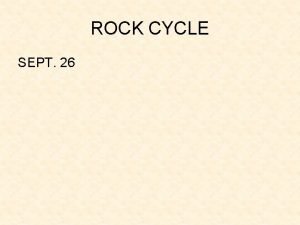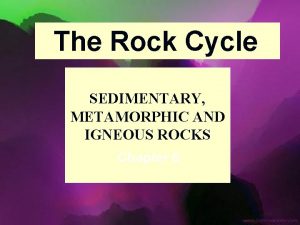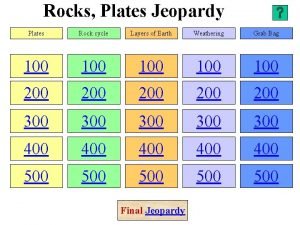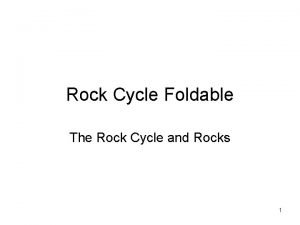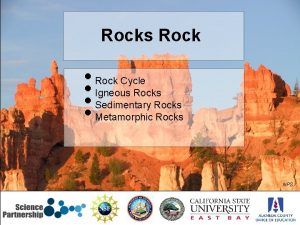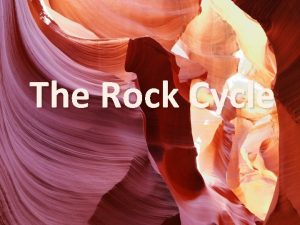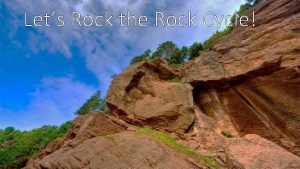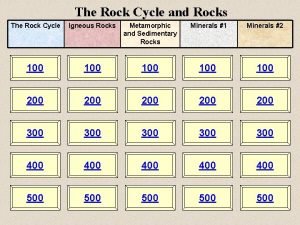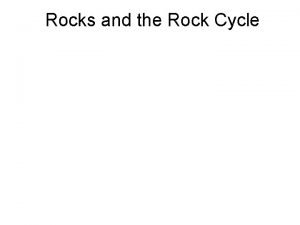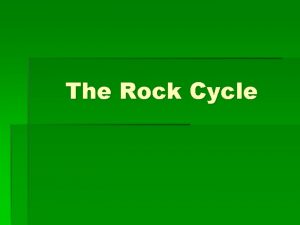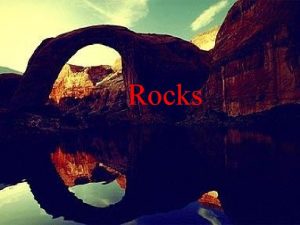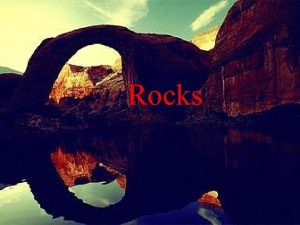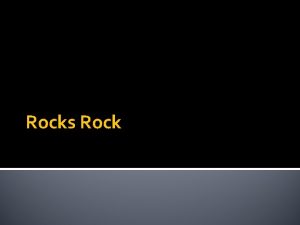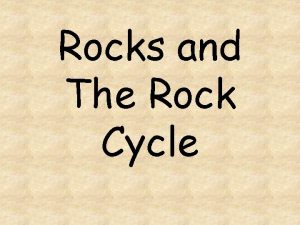Rocks Types of Rocks and The Rock Cycle




















- Slides: 20

Rocks!!!!!!!!! Types of Rocks and The Rock Cycle https: //www. youtube. com/watch? v=6 bky. Xv. YP 4 j. M



Ø The Rock Cycle is a group of changes, this change does not necessarily have to be a chemical change. Ø Igneous rock can change into sedimentary rock or into metamorphic rock. Ø Sedimentary rock can change into metamorphic rock or into igneous rock. Ø Metamorphic rock can change into igneous or sedimentary rock. Ø Almost all of rock today that we have on earth is made up of all the same stuff as the rocks that dinosaurs and other ancient life forms walked, crawled, or swam over Ø While the stuff that rocks are made of has stayed the same, the rocks themselves, have not Ø Over time rocks are recycled into other rocks Ø Moving tectonic plates are responsible for destroying and forming many types of rocks The Rock Cycle

ØWhen classifying a rock sample geologists observe the rock’s color and texture and determine its mineral composition. ØTexture: the size, shape, and pattern of the rock’s grain. ØColor: the apparent color of the rock, on the inside and the outside. ØMineral composition: The minerals that make up the different parts of a rock. Classifying Rocks

�Forms when magma (liquid rock)cools and hardens �Lava = when magma cools at the Earth’s surface �Two Types of Igneous Rocks: ◦ Intrusive Igneous Rocks ◦ Extrusive Igneous Rocks

Should I Jump?

�Formed when magma cools and hardens slowly deep underground �Large crystals �Examples: Granite ◦ Diorite ◦ Gabbro Intrusive Igneous Rocks

�Formed when lava cools rapidly at Earth’s surface �Fine grained crystals �Example: ◦ Basalt ◦ Andesite Extrusive Igneous Basalt

Obsidian Gabbro

�Made up of accumulations of various types of sediment from weathering and erosion �Formed by compaction and cementation ◦ Compaction: air and water is squeezed out of sediment by great heat and pressure ◦ Cementation: dissolved minerals left by water bind the sediment together Sedimentary Rocks

Cementation Compaction

�Clastic Sedimentary: �Formed by rock fragments deposited by erosion. (wind, water, glacier, etc. ) �Example: sandstone, shale �Sandstone Three Types of Sedimentary Rocks

�Chemical Sedimentary Rocks: �Formed from minerals once dissolved in water. �Examples: �Limestone ◦ Limestone* ◦ Gypsum Three Types of Sedimentary Rocks

�Organic Sedimentary Rocks: �Formed from the remains of living things �Examples: Coal ◦ coal ◦ Organic limestone Three Types of Sedimentary Rocks

Shale Gypsum

�Formed by the changing of one type of rock to another by heat, pressure and chemical processes. �Caused by the heat and pressure produced by the movement of tectonic plates against one another Metamorphic Rock

�Foliated: �Extreme pressure flattens crystals into parallel bands of different densities. �Examples: Gneiss ◦ Slate ◦ Schist ◦ Gneiss Two Types of Metamorphic Rocks

�Unfoliated: Marble �Do not have bands of crystals �Examples: ◦ Quartz (from sandstone) ◦ Marble (from limestone) Two Types of Metamorphic Rocks

Ø Over time rocks are recycled into other rocks Ø Moving tectonic plates are responsible for destroying and forming many types of rocks Ø Igneous rock can change into sedimentary rock or into metamorphic rock. Ø Sedimentary rock can change into metamorphic rock or into igneous rock. Ø Metamorphic rock can change into igneous or sedimentary rock. The Rock Cycle
 Igneous metamorphic and sedimentary
Igneous metamorphic and sedimentary Compaction and cementation
Compaction and cementation Draw rock cycle
Draw rock cycle Rock types and cycle quick check
Rock types and cycle quick check A rock climber's shoe loosens a rock and her climbing buddy
A rock climber's shoe loosens a rock and her climbing buddy Chapter 3 standardized test practice answers
Chapter 3 standardized test practice answers Extrusive rock
Extrusive rock Andesite vs basalt
Andesite vs basalt Rock cycle
Rock cycle Rock climb
Rock climb Sedimentary rock concept map
Sedimentary rock concept map The rock cycle concept map
The rock cycle concept map How does soil link the rock cycle and biosphere?
How does soil link the rock cycle and biosphere? Rock cycle explanation and diagram
Rock cycle explanation and diagram Rock cycle comic strip
Rock cycle comic strip Rock cycle song for kids
Rock cycle song for kids Rock cycle
Rock cycle Rock cycle jeopardy
Rock cycle jeopardy Rock cycle song
Rock cycle song Rock cycle
Rock cycle Rock cycle foldable
Rock cycle foldable



